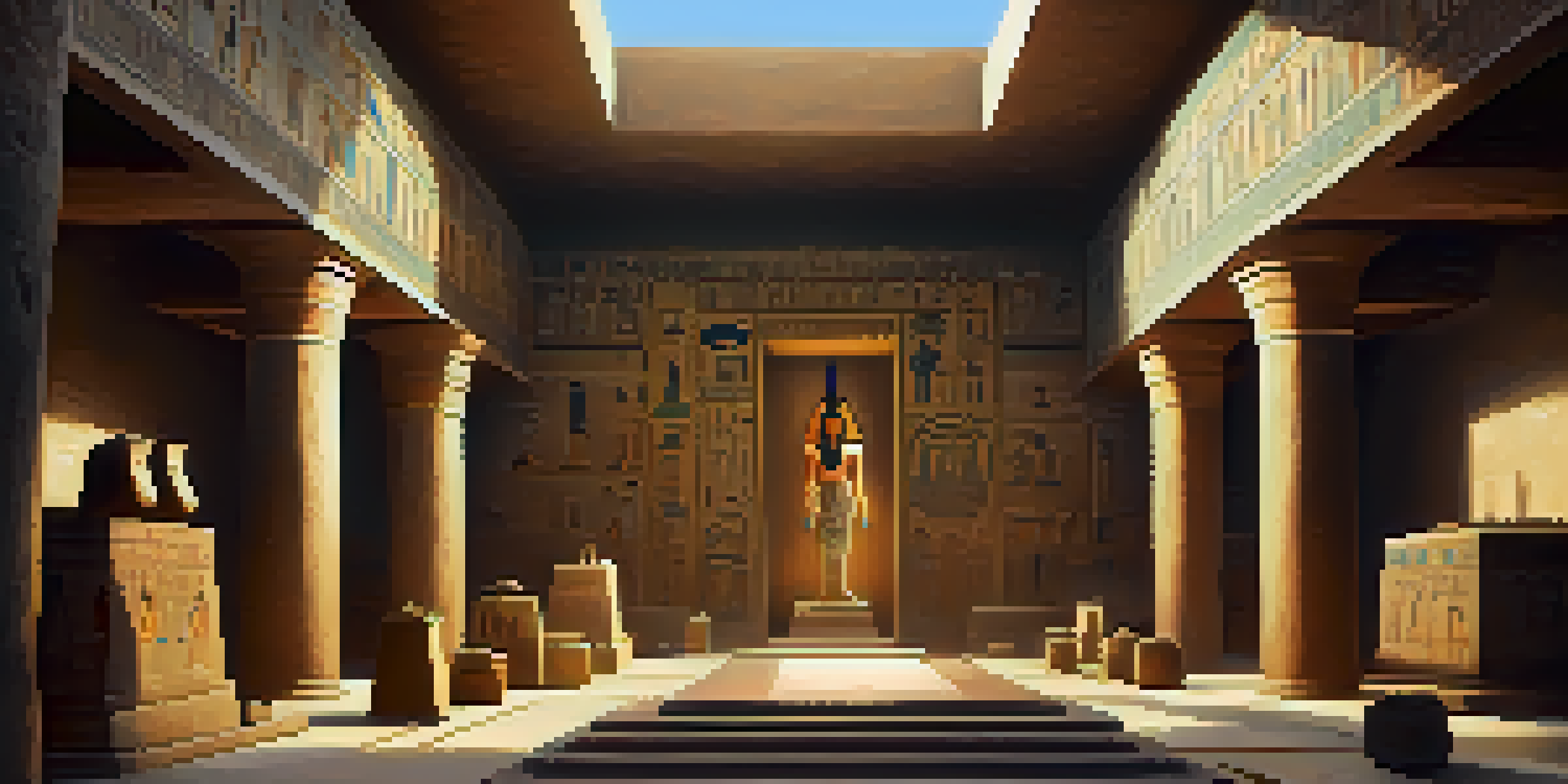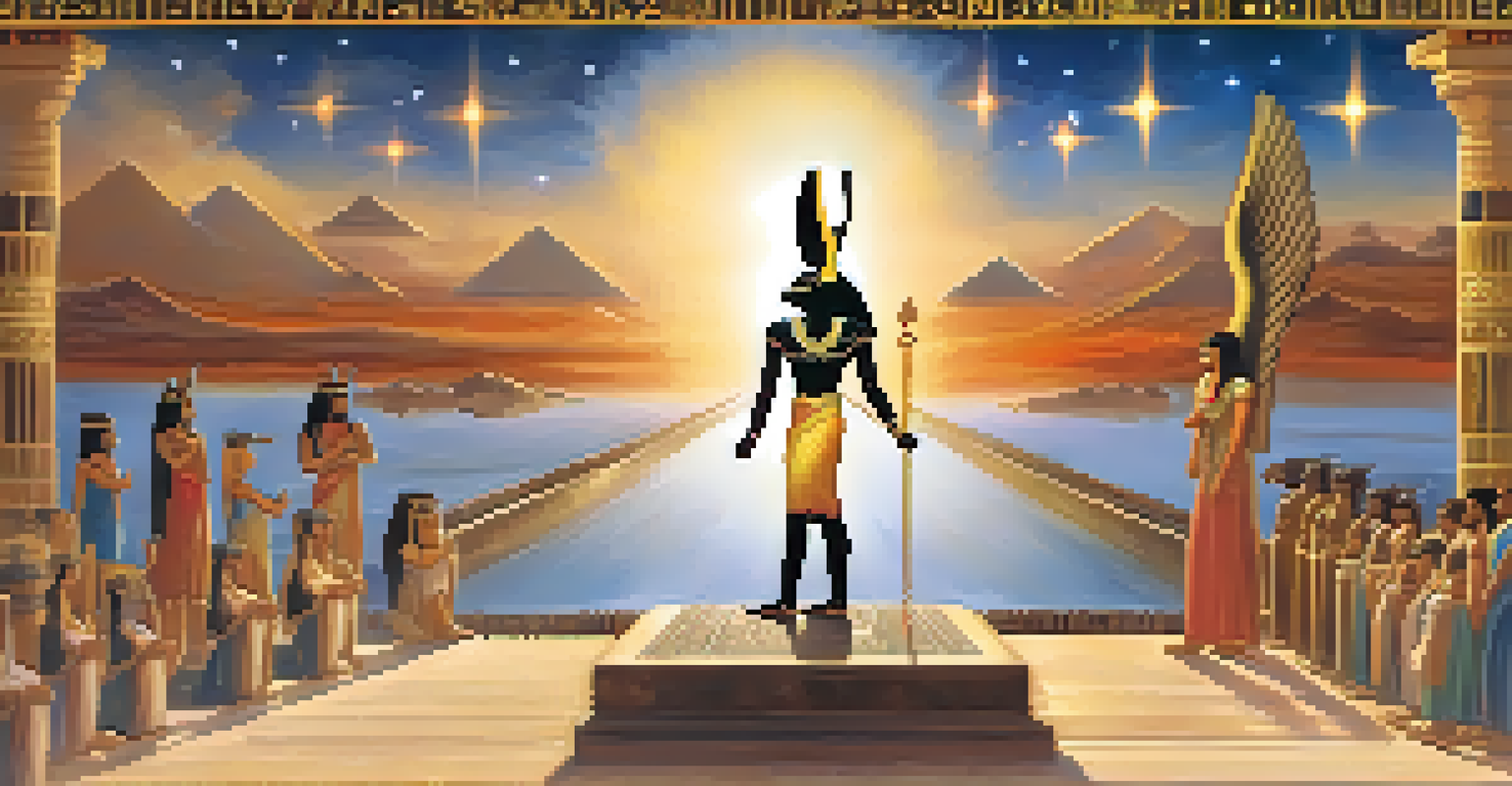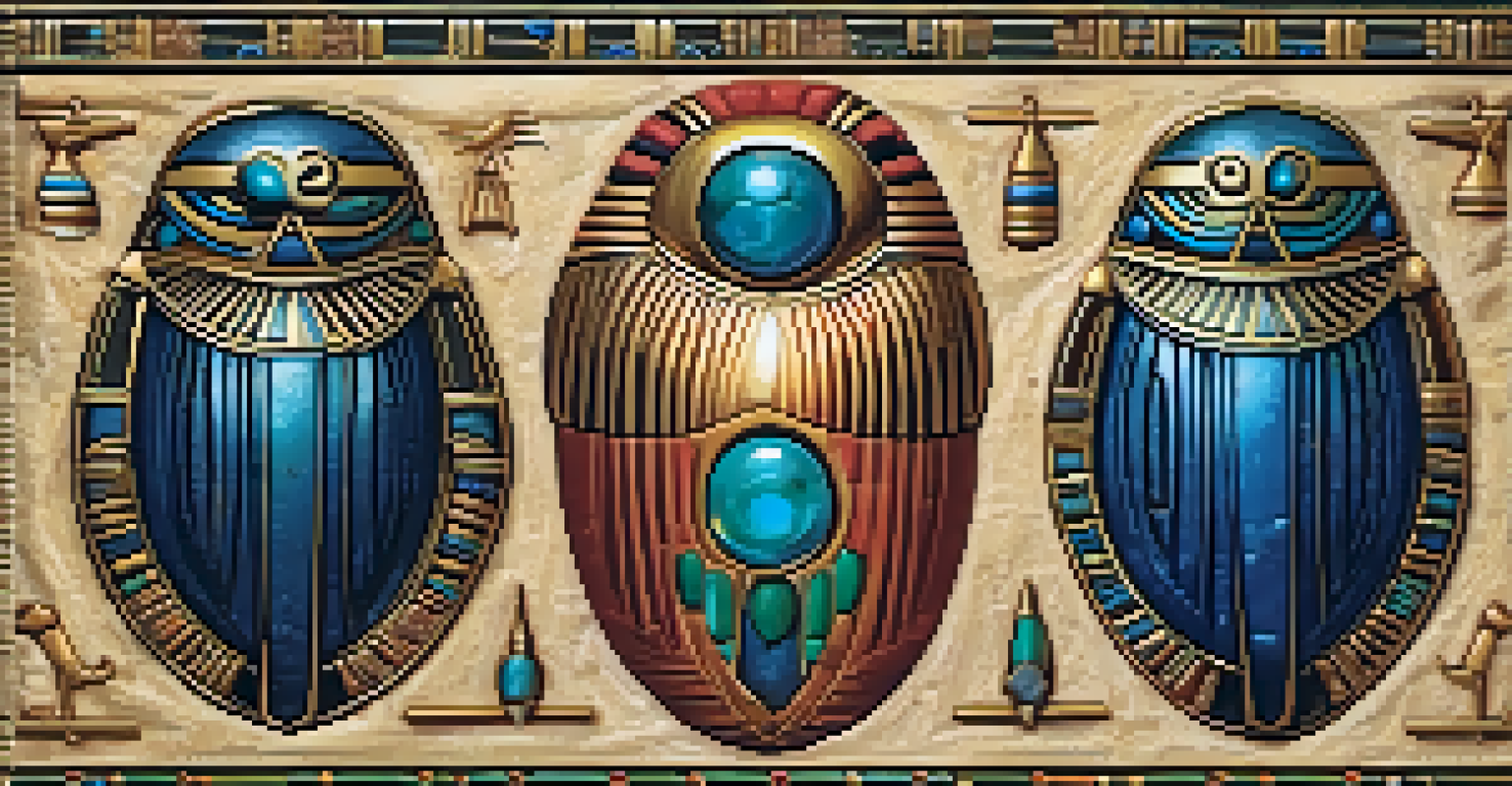The Influence of Ancient Egypt on Soul Beliefs Today

Understanding Ancient Egyptian Soul Concepts
Ancient Egyptians had a profound understanding of the soul, which they believed was made up of several components, including the Ka, Ba, and Akh. The Ka represented a person’s life force, while the Ba was linked to personality, often depicted as a bird. These elements highlight how they viewed the soul as multifaceted, which is a concept that resonates in various spiritual beliefs today.
The soul is the essence of who we are, and its journey transcends the physical realm.
Furthermore, Egyptians believed that when a person died, their soul would embark on a journey through the afterlife, facing judgment. This journey was not just about the soul's fate; it reflected their earthly actions and moral conduct, emphasizing accountability. This idea of an afterlife journey continues to influence many religions and spiritual practices around the world.
The rich symbolism and rituals surrounding the soul in ancient Egypt serve as a foundation for understanding the human experience. Their belief in the soul's immortality created a culture that revered life and the afterlife, which can be seen in modern philosophies that embrace similar themes of legacy and continuity.
The Role of the Afterlife in Ancient Egyptian Beliefs
The afterlife held immense significance in ancient Egyptian culture, shaping their daily lives and practices. Egyptians constructed elaborate tombs and performed rituals to ensure a smooth transition into the afterlife, reflecting their deep-seated belief that this life was merely a preparation for the next. This commitment to the afterlife speaks volumes about their understanding of existence beyond physical death.

Today, many cultures similarly prioritize preparation for an afterlife, whether through religious rites or personal practices. For example, concepts found in Christianity and Islam echo ancient beliefs, such as judgment after death and the existence of heaven and hell. These parallels indicate how the ancient Egyptian view of the afterlife has permeated various spiritual doctrines over time.
Soul Components: Ka and Ba
Ancient Egyptians viewed the soul as multifaceted, comprising the Ka, a life force, and the Ba, linked to personality, highlighting a complex understanding of human essence.
Moreover, the rituals and artifacts from ancient Egypt, like the Book of the Dead, continue to intrigue and inspire modern interpretations of the afterlife. They serve as reminders of humanity's enduring quest to understand what lies beyond, bridging the gap between ancient beliefs and contemporary spiritual practices.
The Ka and Ba: Life Force and Personality
The concepts of Ka and Ba illustrate the Egyptians' nuanced understanding of the soul's components. The Ka, representing the life force, was believed to remain in the tomb, while the Ba could travel freely between the living and the dead. This distinction emphasizes how ancient Egyptians viewed the interplay between physical existence and spiritual essence, a notion that resonates in many modern belief systems.
The heart is where the soul resides, guiding us through the moral choices we make in life.
In today's context, the idea that our personality (akin to the Ba) can interact with the world even after death can be seen in the ways people honor their loved ones. Activities like remembering the deceased through stories, celebrations, or rituals reflect the belief that their essence lives on. This ongoing connection with those who have passed highlights the enduring impact of ancient Egyptian soul beliefs.
Furthermore, the Ka and Ba concepts have inspired modern interpretations of duality in human nature. Philosophers and spiritual leaders often discuss the balance between body and spirit, mirroring the ancient Egyptian understanding of the soul's complexity. This philosophical connection underscores how ancient ideas continue to influence contemporary thought.
Ancient Egyptian Rituals and Their Modern Echoes
Rituals played a central role in ancient Egyptian society, particularly concerning the soul's journey after death. From mummification to offerings for the deceased, these practices were designed to honor and sustain the soul's existence in the afterlife. Today, various cultures maintain similar rituals, celebrating the lives of those who have passed while acknowledging their ongoing presence in spirit.
For instance, many cultures observe rituals like Día de los Muertos in Mexico, where families gather to remember and celebrate their deceased relatives. This practice mirrors the ancient Egyptians' belief in maintaining a connection with the dead, showcasing the universal desire to honor and remember loved ones. Such rituals reinforce the idea that while physical bodies may perish, the spirit remains alive in memory and tradition.
Afterlife's Importance in Culture
The ancient Egyptian belief in the afterlife significantly influenced their daily practices and reflects a broader human desire for connection beyond physical death.
Additionally, the importance of rituals in both ancient and modern contexts highlights humanity's intrinsic need for connection. By participating in these practices, people find comfort and meaning, illustrating how ancient Egyptian beliefs about the soul continue to resonate and inform contemporary life.
The Heart as the Center of the Soul in Ancient Egypt
In ancient Egyptian belief, the heart was considered the seat of the soul and the center of a person's being. During the judgment process, the heart was weighed against the feather of Ma'at, symbolizing truth and justice. This emphasis on the heart as a moral compass reflects a deep understanding of ethics and accountability that is still relevant in today's discussions about morality and conscience.
Modern interpretations often depict the heart as a symbol of love and emotion, reinforcing the idea that it holds significant meaning beyond a mere physical organ. This connection to the heart continues to inspire countless expressions of love and compassion, demonstrating how the ancient Egyptian view has shaped contemporary values around morality and ethical behavior.
Furthermore, various spiritual practices today emphasize the importance of heart-centered living, advocating for compassion and integrity. This notion echoes the ancient Egyptians' belief in the heart's role in determining one's fate in the afterlife, creating a bridge between ancient wisdom and modern ethical frameworks.
Influence of Ancient Egyptian Art on Modern Spirituality
The artistry of ancient Egypt, rich with symbolism related to the soul and afterlife, continues to inspire modern spirituality and aesthetics. From hieroglyphics to intricate tomb paintings, these artworks serve as reminders of the cultural significance placed on the soul's journey. Today, artists and spiritual seekers alike draw on these ancient symbols to convey deeper meanings in their work.
Modern spiritual practices often incorporate visual elements reminiscent of ancient Egyptian art, using symbols like the Ankh or Eye of Horus to represent life and protection. These symbols not only pay homage to ancient beliefs but also serve as tools for meditation and reflection in contemporary spiritual practices. Such usage illustrates how art transcends time, connecting us to our ancestors' beliefs and values.
Heart as Moral Center
In ancient Egypt, the heart symbolized the soul's essence and moral accountability, a concept that continues to resonate in contemporary discussions of ethics and compassion.
Moreover, the fascination with ancient Egyptian art speaks to humanity's quest for understanding the mysteries of life and death. By exploring these artistic expressions, people can connect with the profound spiritual themes that have persisted through centuries, highlighting the enduring influence of ancient Egypt on today's spiritual landscape.
Conclusion: The Lasting Impact of Ancient Egyptian Soul Beliefs
The influence of ancient Egyptian beliefs about the soul is evident in various aspects of modern spirituality, ethics, and cultural practices. Their multifaceted understanding of the soul, rituals surrounding the afterlife, and the significance of the heart resonate deeply with contemporary beliefs about existence and morality. This rich heritage offers valuable insights into what it means to live a meaningful life.
As we navigate our own beliefs and practices today, we can draw inspiration from the wisdom of ancient Egypt. Their emphasis on accountability, connection to the afterlife, and the importance of honoring our loved ones can guide us in our spiritual journeys. This interconnectedness between past and present illustrates how ancient wisdom remains relevant in our quest for understanding.

Ultimately, the legacy of ancient Egypt serves as a reminder of our shared human experience. By acknowledging and exploring these historical beliefs, we can enrich our understanding of ourselves and our place in the world, fostering a deeper appreciation for the spiritual threads that connect us all.